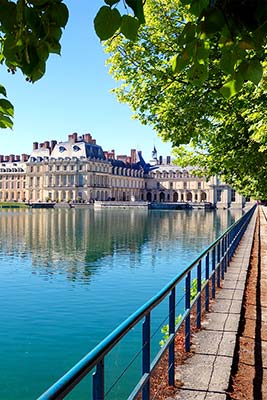
Vaux-le-Vicomte • Fontainebleau • Chantilly
ORIENTATION TO VAUX-LE-VICOMTE
The region around Paris (called the Ile de France) is studded with sumptuous palaces. The city’s booming elite class made this the heartland of European château-building in the 16th and 17th centuries. Most of these châteaux were lavish hunting lodges—getaways from the big city. The only things they defended were aristocratic egos.
If you’re planning to visit just one palace in all of Europe, it should be Versailles (see previous chapter). But unlike heavily touristed Versailles, the three châteaux recommended here are quiet (at least on weekdays), letting you enjoy their original pastoral ambience. Consider visiting at least one; they are each very different.
For sheer beauty and intimacy (open daily, closed Nov-March); see next page.
For its history, ease of access, superb interior, and pleasant city (closed Tue, covered by Paris Museum Pass); see here.
For its beautiful setting and fine collection of paintings (open daily, closed Tue Nov-March, covered by Paris Museum Pass); see here.
Transit Passes: Travelers with a five-zone Navigo Découverte pass can use it to get to Fontainebleau and Vaux-le-Vicomte, but not to Chantilly. Without this pass, day-trippers to Vaux-le-Vicomte or Fontainebleau should purchase a Navigo Jour pass covering zones 1-5, which includes a day of travel in the greater Paris region (€20.10, buy at any Métro station or at most tabacs). This single-day pass covers Métro and train rides to and from the train stations at Melun and Fontainebleau. This pass also includes the bus from the train station to the Fontainebleau château (see here for more on these passes). Validate your pass before boarding the train at the Gare de Lyon (the machine is at the front of the track).
There are no passes that work for Chantilly; travelers heading there must buy individual train tickets (see later in this chapter).
Versailles may be most travelers’ first choice for its sheer historic importance, but Vaux-le-Vicomte (voh luh vee-komt) is just flat-out ravishing. With a harmony of architecture, interior decor, and garden design that you won’t find anywhere else, it gets my vote for one of the most beautiful châteaux in all of France.
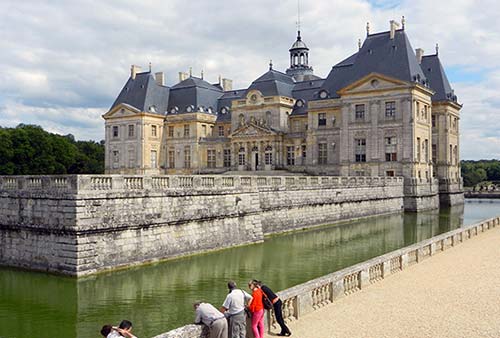
Compared with Versailles, it’s also more intimate, better furnished, and comes with a fraction of the crowds. While getting to Vaux-le-Vicomte requires more effort, it’s an absolute joy to tour. Located in a huge forest, with magnificent gardens and no urban sprawl in sight, Vaux-le-Vicomte gives me more than a twinge of palace envy.
By Train via Melun: Using a Navigo five-zone pass you can take Transilien trains to Melun from Gare de Lyon (nearly hourly, 30 minutes; direction: Montereau, Montargis, or Laroche-Migennes, usually from Hall 1, tracks L-M; Melun is the first stop). The slower RER/Train D runs to Melun from Gare de Lyon, Gare du Nord, or Châtelet-Les Halles (direction: Melun, 3/hour, 50 minutes). The last return train from Melun to Paris departs at about 23:45.
From Melun’s train station, taxis make the 15-minute drive to Vaux-le-Vicomte (about €25 one-way Mon-Sat, €30 evenings and Sun; book online, https://taxi91cesson77.wixsite.com/taxi, or call +33 1 64 52 51 50 or +33 7 81 92 51 95). Ask a staffer at the château to call a cab for your return, or schedule a pickup time with your driver. Seek other visitors to split the fare with. The château sometimes runs a weekend shuttle-bus service to and from the station (€10 roundtrip, check château website for current status).
By Excursion Bus: The City Vision tour company offers a handy excursion bus that combines Vaux-le-Vicomte and Fontainebleau, making this day trip a breeze (from €105, includes châteaux entry; runs April-Oct a few days a week, check website, +33 1 44 55 60 00, www.pariscityvision.com).
By Car: From Paris, take the A-6 autoroute toward Lyon, then follow signs to Melun. In Melun, follow signs to Meaux, then Vaux-le-Vicomte.
Cost: €18—smart to book ahead in high season, €14 for kids 17 and under, €22 for candlelit visits; ticket includes château, gardens, carriage museum, and audioguide, €5 extra for dome climb (kids must be taller than four feet, five inches); family deals available, not covered by Paris Museum Pass.
Hours: Daily 10:00-19:00 except on candlelit-visit days, when the château opens at 11:00 and closes at 24:00 (Sat in mid-May-Sept plus Fri in July-Aug); last entry 1.5 hours before closing.
The château is generally closed in winter (Nov-March) but often reopens, with special decorations, during the holidays (weekends only Dec-early Jan).
Information: +33 1 64 14 41 90, www.vaux-le-vicomte.com.
Tours: The excellent audioguide is included, supplemented by posted explanations in English in rooms.
Services: Parking is easy and free. The gift shop has fine palace guidebooks. Outside the shop are a modern WC and the $ L’Ecureuil (“The Squirrel”) cafeteria, with a limited but reasonably priced selection (daily 12:00-17:00, until 22:30 during candlelit visits). Picnics are welcome in designated areas before you enter the grounds or on the very far end of the gardens. A variety of additional activities is possible for a price, including period costume rentals.
Candlelit Visits: On Fridays and Saturdays in high season, the château opens and closes later for candlelit visits (see “Hours,” above). Two thousand candles illuminate the palace, and piped-in classical music and impressive fountains provide ambience. These visites aux chandelles re-create a party thrown in Louis XIV’s honor in 1661. Note that the gardens are hard to see by candlelight, so arrive while the sun’s still up and tour the gardens first (but also note, from late May through July, it doesn’t get truly dark until around 22:00). Fancy dinners are available on these nights in the Les Jardins de la Fontaine restaurant (€60 menus, reservations required—book online).
When Vaux-le-Vicomte and Versailles were built, France was slowly heading toward a revolution. Of its 18 million people, 200,000 were clergy (“those who pray”), 150,000 were nobles (those who fight or “carry a sword”), and the rest (17.6 million) were the Third Estate (“those who work”). Of course, there was no democracy—just one king and his ministers who ran the show. Somewhat like modern bankers and financiers, these people controlled the workings of the economy, amassing almost unfathomable wealth.
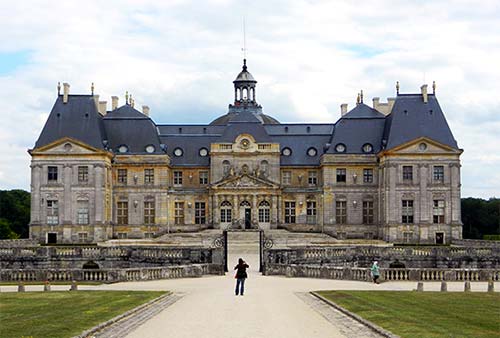
One of them was Nicolas Fouquet, France’s finance minister during the reign of Louis XIV, in the 17th century. Vaux-le-Vicomte was his home. A brilliant collaboration between three masters—architect Louis Le Vau, artist Charles Le Brun, and landscape designer André Le Nôtre (who pioneered the French formal garden)—this château was the architectural inspiration for Versailles and set the standard for European palaces to come. In fact, after several visits to the château, a very young Louis XIV found himself impressed that one man could create such magnificence. He was also curious how one man (other than himself) could pay for it. So, Louis had the overly ambitious Fouquet arrested, hired his talented trio, and proceeded to have his bigger and costlier (but not necessarily more splendid) palace of Versailles built.
Monsieur Fouquet’s arrest features prominently in the third Musketeer book by Alexandre Dumas (and at least two versions of The Man in the Iron Mask were filmed here). From the prison cell where he died, Fouquet wrote longingly of his lost home, “This was the estate I regarded as my principal seat and where I intended to leave some traces of the status I had enjoyed.”
If the château feels a bit quirky in the way it’s run today, remember it’s not national property. It’s private. The château has been in the same family for five generations and was opened to the public in 1968 by Patrice de Vogüé, who still lives on the grounds (but not in the château).
Start your tour in the stables, at the fine Museum of Carriages (Musée des Equipages), where you can gallop through two long halls lined with elegant carriages from a time when horses were a big part of daily life. The exhibit begins with a reminder that when the château was built, France had 2.5 million horses (more than 100 horses per thousand people). Today France has 300,000 horses (just five per thousand people). While these stables are worth a look, there is no English info other than the entrance and exit signs.
Next, stroll like a wide-eyed peasant across the stone bridge that spans the ornamental moat facing the palace (look for lazy carp in the water). Take some time to survey the grand design and admire the symmetry and elegance of the grounds, the outbuildings, and the palace itself. The gardens stretch far beyond the palace, but their main axis runs straight through the center of the château.
Enter the palace (and pick up the included audioguide—and maybe a costume). As you wander through Fouquet’s dream home, you’ll understand Louis XIV’s envy and Fouquet’s nightmarish fate from the dramatic audioguide narration. Versailles was a simple hunting lodge when this was built. Most of the paintings and furniture you’ll see here are not original—Louis confiscated what he liked for Versailles.
The one-way route first takes you through lavish rooms, then gives you the option of climbing upstairs to a simple attic for an exhibition on carpentry and a peek at the wood structure of the building. If you’ve opted for the dome climb, you can scale 80 steps between the beam-packed inner and outer domes (claustrophobic for some, and a lesson in how Notre-Dame burned). You’ll emerge at a small terrace at the very top, with a fine view over the magnificent grounds—the very first French formal gardens.
Continue through the last rooms on the tour route—these are among the best and are explained with concise histories on the walls. Next, make your way to the lower levels of the château to see the servants’ dining room and the castle’s kitchen, possibly passing by a room re-creating the prison cell from The Man with the Iron Mask film, which used the château as its backdrop. Your visit ends with a room dedicated to Fouquet’s accomplishments.
Exit and stand on the palace’s back steps to survey André Le Nôtre’s first claim to fame. This garden was the cutting edge of sculpted French gardens. The designer integrated ponds, shrubbery, and trees in a style that would be copied in palaces all over Europe. Consider the 30-minute walk (one-way) to the viewpoint atop the grassy hill far in the distance. Rentable golf carts make the trip easier (€20/45 minutes, 4 passengers maximum, ID and deposit required).
When it comes to showing the sweep of French history, the château of Fontainebleau is unrivaled among French palaces. But don’t expect Versailles-like unity here. It’s a gangly series of wings that has grown with centuries of kings. Still, I find the architecture and lavishly furnished rooms more appealing than Versailles, and you won’t encounter Versailles crowds here. It’s a delight to visit (though the gardens are ho-hum).
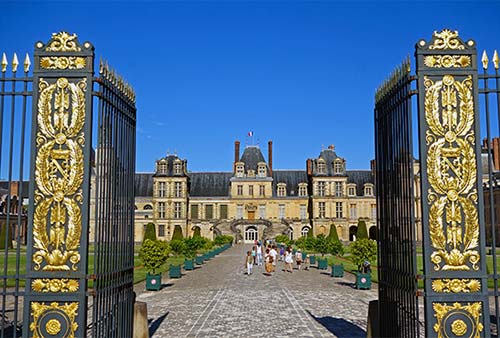
Its core was built by François I in 1528 over medieval foundations. While Vaux-le-Vicomte and Versailles are French-designed, Fontainebleau was built a century earlier by an Italian. Inspired by his travels through Renaissance Italy, François I hired Italian artists to build his palaces. He even convinced one artist—Leonardo da Vinci—to abandon his native Italy and settle in France for the last three years of his life.
It seems every king, queen, and emperor since has loved this place—Louis XIII was born here, Louis XV got married here, and Napoleon III was baptized here. And many years later, General George Patton set up headquarters here on his way to Berlin.
Above all, Fontainebleau has more Napoleon Bonaparte connections than any other palace in France. It was here that the pope met Napoleon before the general’s 1804 coronation as emperor. And it was from the château’s famous horseshoe-shaped staircase that Napoleon gave his stirring abdication speech, trading his rule of France for exile to Elba in 1814.
Tourist Information: Fontainebleau’s TI is located in the city center in the pedestrian-only Place de la République, a 15-minute walk from the château (turn right out of the château courtyard and walk down Rue Denecourt to get there). It has hiking and biking maps, information on where to rent bikes fit for the forest trails, and posted train/bus schedules (Mon-Sat 10:00-18:00, Sun 10:00-13:00 & 14:00-17:30, Nov-March closed Sun afternoon, 4 Place de la République, +33 1 60 74 99 99, www.fontainebleau-tourisme.com).
By Train: For a day trip to Fontainebleau, use a Navigo Découverte or Navigo Jour pass—see details at the start of this chapter.
Main-line trains from Gare de Lyon are the best way to reach Fontainebleau-Avon station (nearly hourly, 45 minutes, direction: Montereau, Montargis, or Laroche-Migennes). Trains leave from the Grandes Lignes tracks, mostly in Hall 1, tracks L to N. Arrive at your track at least 20 minutes early to validate your pass (scanner is on the post as you approach the track).
From Fontainebleau-Avon station, take a bus or taxi to reach the château. Bus line 1 (direction: Les Lilas/Château) leaves from the first bus stall, marked #1-Château, and makes the 15-minute trip to the Château stop (4/hour, €2.10 if purchased on board, Navigo passes valid—validate onboard, fewer buses on Sun).
To return to the station, board bus #1 (direction: Avon Gare) at the stop directly across from the château, in front of the recommended Restaurant L’Ecallier du Château. Confirm when you board by asking, “Ce bus va à la gare?” (seh bews vah ah lah gar?).
A taxi from the train station to the château costs about €10 and is probably worth the convenience (taxis are scarce on Sun and after 19:00, call +33 6 07 30 13 09).
By Car: Follow signs to Centre, then Château. Several lots are close by, including Parking du Château next to the Hôtel Londres and Parking du Marché near the TI. To reach Vaux-le-Vicomte from Fontainebleau (about 20 minutes), follow signs to Melun.
Cost: €14, free for kids 17 and under, free first Sun of the month except July-Aug, €10 last hour of the day, covered by Paris Museum Pass. It’s smart to buy a timed-entry ticket online in advance in high season. If you don’t have an advance ticket or Museum Pass and there’s a line, try the easy-to-use ticket machines in the main entrance, just past security.
Hours: Wed-Mon 9:30-18:00, Oct-March until 17:00, closed Tue year-round, last entry 45 minutes before closing. The ballroom often closes one hour before the château, and the Papal Apartment is sometimes closed 11:30-14:30.
Information: +33 1 60 71 50 70, www.chateaudefontainebleau.fr [URL inactive].
Tours: Rooms have basic explanations posted in English, but specific objects are described only in French, making the €4 videoguide a worthwhile investment for those who want the details.
Petit Train: This tram starts just inside the main gate and does a 35-minute loop through the gardens on the hour, starting at noon (€8).
Services: Free lockers are available to store your bags.
The château’s complex floor plan can seem overwhelming, but visitors follow a one-way route when touring the place—don’t struggle to understand the overall design. Find the entry (inside the main gate on the right), and follow the Sense de la Visite signs through the Napoleon I Museum, special exhibit, and royal apartments.
The Napoleon I Museum comes first and is fascinating. Turn left immediately into the first room, which features grand portraits of Emperor Napoleon at 35 (he looks younger) and his first wife, Empress Josephine (painted after their coronation). The next rooms—each drenched in the Empire style—are dedicated to Napoleon at war; you’ll see his battle coat, tent, camp gear, and “necessities” (silverware and toiletries). You’ll also learn about his second wife, Empress Marie Louise (whom he married for her Habsburg heritage, hoping it would color his Corsican blood blue), and their son, the “King of Rome,” Napoleon II (whose crib you’ll see). He lived in exile after his dad’s defeat and died of tuberculosis at 21.
You’ll do a U-turn down a hallway lined with busts and large portraits of the sprawling imperial family Napoleon created—relatives he put on various thrones across his empire. Looking at the final painting, which depicts Napoleon with symbols of the legal system he gave France—the “Code Napoléon”—it’s fascinating to consider the mix of idealism, charisma, and megalomania of this leader. This revolutionary hero came out of a movement that killed off the old regime—only to create a new old regime.
Continuing straight, enter the sumptuous royal apartments. Tour these counterclockwise starting with the Papal Apartment, renovated by Napoleon to house Pope Pius VII. His bedroom is impressive, but it’s like chump change compared to Anne of Austria’s a few rooms farther on. All those heavy tapestries hanging like wallpaper helped keep things warmer in winter. (The château was founded as a hunting lodge, and hunting is best in the winter after leaves fall, so maintaining some warmth in the rooms was a top priority.)
The stunning wood-paneled Renaissance hall of François I, which dates from 1528, inspired other royal galleries, including the Hall of Mirrors at Versailles. The opulent ballroom (salle de bal) comes with piped-in music and has garden views that evoke royal fêtes. The Galerie de Diane, converted to a library, is almost a football field in length—that’s a lot of books. The last hall you’ll tour houses Napoleon’s throne room, the only French salle du trône that survives with its original furniture, including the emperor’s bathroom, bed, and very important-looking desk.
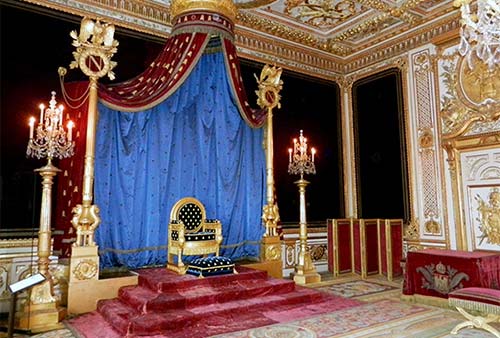
The palace is slathered in royal and imperial symbolism, and its walls are hung with exquisite tapestries. As you walk its halls, track the artistic shift in style, from Renaissance to Rococo—which has a kind of whimsy that infuriated the revolutionary mobs—to the soberer, postrevolutionary Neoclassical.
After touring the palace, the gardens—designed in the 17th century by landscape architect André Le Nôtre—are worth a stroll.
The town itself has a helpful TI (described earlier), a few hotels, and lots of eating options. The English bookstore ReelBooks, at 9 Rue de Ferrare, has a good collection of new, used, and children’s books. If you stop in, say hi to Sue (Tue-Sat 11:00-19:00, open some Sun, closed Mon, +33 1 64 22 85 85).
Sleeping: $$$ Hôtel de Londres*** is run by avid golfer Philippe and his brother Bruno, who rent 16 immaculate and tastefully designed rooms, half with great views of the château, all with air-conditioning, some with balconies. They also loan out free golf clubs—one of France’s most famous golf courses is close by (no elevator, 1 Place du Général de Gaulle, +33 1 64 22 20 21, www.hoteldelondres.com, hdelondres1850@aol.com).
$$-$$$ Hôtel Ibis Château de Fontainebleau,*** a five-minute walk from the château, is big, central, clean, and easy, but their prices vary wildly depending on the date you choose (18 Rue Ferrare, +33 1 64 23 45 25, www.ibishotel.com, h1028@accor.com).
$ Hôtel Belle Fontainebleau** delivers modest two-star comfort (no A/C, no elevator) at decent prices and is well located near the château and town center (1 Rue de la Chancellerie, +33 1 64 22 31 70, www.hotel-belle-fontainebleau.com, hotel.bellefontainebleau@orange.fr).
Eating: Scads of restaurants, and shops perfect for picking up picnic fare, are in the town center. To reach the center, turn right from the château courtyard and walk down Rue Dénecourt. There’s a big Monoprix at 58 Rue Grande and an appealing collection of pedestrian lanes that begin after Place Napoléon Bonaparte. Rue des Sablons, which parallels Rue Grande, is a market street with cheese shops, bakeries, fruit stands, and butchers roasting chickens. Rue Montebello is restaurant row; you’ll find quieter places along the lanes off Rue de la Corne.
$$ L’Ecallier du Château sits right across from the château. Dynamic owner Alessandra spoils her clients with delicious, reasonably priced seafood and meat dishes (in fine sauces). There’s comfortable seating inside and out (no lunch Tue-Wed, no dinner Sun, 3 Rue Royale, +33 1 60 96 73 21).
$$ L’Air du Temps is a cheery and modestly stylish little place serving tasty, well-presented dishes that change with the seasons (closed Tue-Wed, 32 Rue de France, +33 1 60 74 07 48).
$$ Le Grand Café, occupying a pretty spot on the main square, serves convenient brasserie dishes (daily, 33 Place Napoléon Bonaparte, +33 1 64 22 20 32).
Chantilly (shahn-tee-yee), 30 minutes north of Paris, floats serenely on a reflecting pond. This extravagant hunting palace delivers a peaceful château setting, great art, and formal (read: no flowers) French gardens, but you won’t get a feel for authentic château life here. The rooms are 19th-century re-creations, as the place was pretty much razed during the Revolution. And while the famous cream’s invention is often attributed to this château, the sweet white stuff predates the palace by a long shot (though it gained a certain status in the 17th century thanks to the château’s chef).
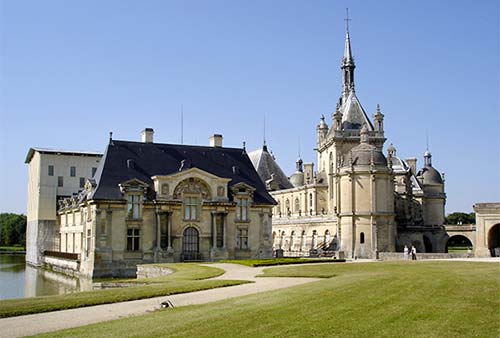
Tourist Information: The TI is located in Chantilly’s town center, a few blocks before the château-like stables (Grandes Ecuries) when coming from the train station (Wed-Sat 9:30-12:30 & 14:00-17:30, Sun until 17:00, closed Mon-Tue, 73 Rue du Connétable, +33 3 44 67 37 37, www.chantilly-tourisme.com).
Taking a train to Chantilly is a breeze, but the last 1.5 miles from the station to the château is tricky unless you spring for a cab (wise idea at least one way) or enjoy a good walk. Leave from Paris’ Gare du Nord for Chantilly-Gouvieux (on the Creil and Compiègne lines, Grandes Lignes). RER/Train-D serves Chantilly, but service is twice as fast on the Grandes Lignes main lines and the same price. Main line trains and RER trains each run about every 1.5 hours (check schedules at www.sncf-connect.com—TER is the faster train). You can also ask at the Gare du Nord information desk for the next departure (fewer on weekends, 25 minutes by TER train, 50 minutes by RER/Train-D, €10 one-way).
Upon arrival in Chantilly, confirm return times to Paris as there are service gaps in the afternoon.
Getting from the Station to the Château: It’s a level, easy-to-follow, 30-minute walk to the château (remember that you’ll also be walking a lot once there). Walk straight out of the train station and cross the big road that separates the town from the woods, turn left, and follow Château signs. The first grand building you see after about 20 minutes is not the château but the elaborate stables, which are worth visiting (the château gate is another five minutes on foot). To walk back to the station, follow the sign from the horse stables and walk the broad path with the racetrack off to your left. You’ll enter the main drag in Chantilly where you’ll turn left (and find cafés, etc.) to the station. Don’t hesitate to ask, “La gare?”
The no-brainer station-to-château trip is by taxi (€10 one-way, Central Taxis, +33 7 65 25 65 25, www.central-taxis-senlis.com; minivans available if you call ahead). The ticket office at the château will call a cab for your return.
The free city DUC bus runs infrequently to the château and usually is not well timed with train arrivals (stop is 75 yards to the left as you leave the train station, no buses on Sun). It’s easier to return to the station by bus; the schedule is posted at the stop across from the château entry (check return times before you enter the château).
Cost: The basic Domaine ticket is €17 (€13.50 for kids ages 7-17, kids under 7 free), covered by Paris Museum Pass. The basic ticket covers the château, gardens, horse museum (Musée du Cheval), stables (Grandes Ecuries), and dressage horse demonstration (when available). To visit the gardens only, buy the Billet Parc (€9). Or for €30, see it all (including Spectacle Equestre horse show; see below).
Hours: Daily 10:00-18:00, Nov-March Wed-Mon 10:30-17:00, closed Tue; last entry one hour before closing.
Information: +33 3 44 27 31 80, https://chateaudechantilly.fr.
Tours: A free official app in English is available.
WCs: You’ll find WCs at the horse stables and at the entry to the château.
Horse Shows: Horse enthusiasts can buy a €24 ticket for just the horse museum, stables, dressage demonstration (check website for times), and the fancy Spectacle Equestre horse show. These well-choreographed, one-hour performances take place mid-April-June and mid-Sept-Oct on Thu and Sun at 14:30 (show dates and times on website).
A château has stood here since the 1500s and, like so many in the Loire Valley, its aristocratic history is tied to France’s most popular sport at the time, hunting. That explains the focus on horses.
Chantilly has a turbulent history. Because of the social upheaval in France during the Revolution of 1848, the château’s owner, Prince de Condé, fled to England. Twenty years later, when blue blood was safe again in France, he returned to his château with a fabulous collection of art (800 paintings, including three Raphaels) and priceless books. He turned his palace into the museum you see today and willed it to France on the condition that it would be maintained as he left it and the collections would never be loaned to any other museum.
Lacking the grandiose interiors of other châteaux, Chantilly lays its claim to fame with its art collection. The château’s main wing was destroyed during the French Revolution—today’s palace is a fanciful 19th-century reconstruction. The château that you can tour today is divided into three parts: apartments, art gallery, and library.
The château’s lovely waterfront setting is a highlight, though its remarkable art collection is the main draw. Start with the main gallery, through the lavish dining room immediately to the right after entering the château. The art is scattered among many smaller rooms that branch off the main gallery (tour it counterclockwise). Read the handheld translations and wall-posted explanations. Gallery highlights include paintings by Raphael, Poussin, Ingres, Van Dyck, Géricault, and Delacroix (Raphael’s tiny works are in the Santuario room out the left side of the main gallery).
Tour the library and other gold-leafed rooms after the art galleries, each well described in English. Of the 13,000 books in the prince’s library, the most exquisite is the brilliantly illuminated Book of Hours by Jean Fouquet (c. 1460). You’ll exit from the lower level through the book shop and graphite art collection (good Delacroix works here).
Gardens: Immediately behind the château are the geometric and austere gardens. Find the water ponds behind the château and walk down to them. Turn right along the canal following signs for 10 minutes to le Hameau, and find a sweet little garden café (limited menu features pricey desserts served with real Chantilly cream, open April-Oct). This little hamlet of three half-timbered, thatched-roofed homes was the prototype for the more famous hameau at Versailles. While the homes are peasant-simple on the outside, they are lavishly decorated within: The prince had certain needs when he played peasant.
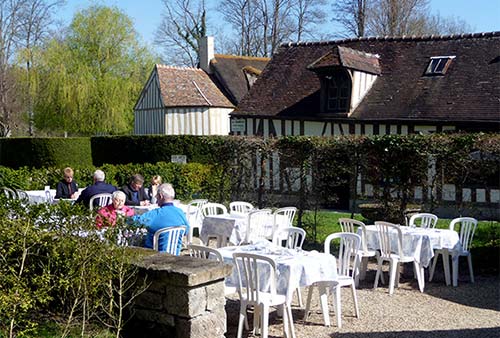
Stables: The prince believed he’d be reincarnated as a horse, so he built an opulent horse château—now a museum/training center (it’s the huge building to the right as you exit the château’s main gate—allow five minutes to walk there from the château; those walking from the station will pass it on the way). I imagine that such a sumptuous structure devoted solely to horses did not go over well with locals in prerevolutionary France.
Today’s horse museum boards horses and boasts 15 well-presented rooms that tell the story of how horses evolved to become essential in human life. The museum is beautifully done, with excellent English explanations and videos, carved wooden horses from carousels, paintings, and examples of riding gear. You might see riders training in the rinks or theater where the shows take place; some demonstrations are more elaborate. To get the most from a visit, plan to see a demonstration (times on website).
There’s a small grocery shop and a café across from the station. You’ll also find many cafés and restaurants in Chantilly town. A lively outdoor market runs on Saturday and Wednesday mornings until 12:30 on appealing Place Omer Vallon (10-minute walk from the château).